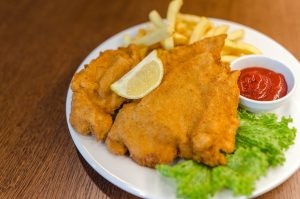🍲German Level 1, Activity 09: Essen / Food (Online)

Products: Traditional German products for breakfast, lunch, dinner, and snack time, Traditionelle deutsche Produkte zum Frühstück, Mittag- und Abendessen, und Snackzeit.
Practices: Understanding the cultural importance of meal times in German speaking countries. Die kulturelle Bedeutung von Essenszeiten im deutschsprachigen Raum verstehen.
Perspectives: Eating together with family and / or friends is important in the culture of German speaking countries. Das gemeinsame Essen mit Familie und/oder Freunden ist in der Kultur des deutschsprachigen Raums wichtig.
NCSSFL-ACTFL World-Readiness Standards:
- STANDARD 1.1 Students engage in conversations, provide and obtain information, express feelings and emotions, and exchange opinions.
- STANDARD 1.2 Students understand and interpret written and spoken language on a variety of topics.
- STANDARD 2.1 Students demonstrate an understanding of the relationship between the practices and perspectives of the culture studied.
Idaho State Content Standards:
- Objective: COMM 1.1: Interact and negotiate meaning (spoken, signed, written conversation) to share information, reactions, feelings, and opinions.
- Objective: COMM 2.1: Understand, interpret, and analyze what is heard, read, or viewed on a variety of topics.
- Objective: CLTR 1.3: Function appropriately in diverse contexts within the target culture.
NCSSFL-ACTFL Can-Do Statements:
- I can recognize food vocabulary when spoken to me.
- I can produce food vocabulary that corresponds to a category (meats, dairy products, fruit, etc.)
- I can identify ingredients in a dish.
Material:
Warm Up
Making a Vocabulary list
1. Show the students the warm-up slide with the varieties of food (meats, dairy products, etc.) .
- Zeigen Sie den Schülern die Aufwärmfolie mit den verschiedenen Nahrungsmitteln (Fleisch, Milchprodukte usw.) .
2. Give them about five minutes to think of words for these categories.
- Geben Sie ihnen etwa fünf Minuten Zeit, um sich Wörter für diese Kategorien auszudenken.
2. Come back together and see what everyone has thought of.
- Komme zurück und teile was Jeder gedacht hat.
3. Use the whiteboard feature on zoom to write down the words.
- Nutze das “whiteboard” auf Zoom und schreibe die Wörter darauf.
Main Activity
Ingredients /Zutaten
1. Show a picture of a meal.
- Zeig ein Bild von einer Mahlzeit.
2. Have the students identify as many ingredients as they can.
- Lassen Sie die Schüler so viele Zutaten wie möglich identifizieren.
Wrap-Up
Create a meal from the items in the shopping cart.
- “Koche” ein Essen von die Sachen im Warenkorb.
End of Activity:
- Read can-do statements and have students evaluate their confidence. (Use thumbs up/thumbs down)
- Encourage students to be honest in their self-evaluation.
- Pay attention, ask questions, and try to use feedback for future activities!
NCSSFL-ACTFL Can-Do Statements:
- I can recognize food vocabulary when spoken to me.
- I can produce food vocabulary that corresponds to a category (meats, dairy products, fruit, etc.)
- I can identify ingredients in a dish.
Cultural Resources
If you order a coffee – Kaffee – in Germany you will receive a cup of black coffee. Over 70% of people in Germany, Switzerland and Austria drink coffee daily. Schorle is a German drink that combines juice or wine with sparkling water, lemonade or lemonlime soda. Apfelschorle (Apple juice mixed with sparkling mineral water) is the most common. Linked is a video about typical German dishes for German speaking countries. White asparagus or Spargel is delicious delicacy and in German speaking countries is known as the “King of Vegetables”. Linked here and here are two interesting articles about this royal vegetable.
How to Remix a Pathways Project Activity
Feeling creative? The Pathways Project needs your help in remixing activities for the K-12 classroom.
Try taking an activity to the next level by:
- Add new content (something you’ve created or another OER source)
- Contribute additional activity suggestions
- Integrate authentic materials such as videos, infographics, photos, etc.
- Suggest how to implement the activity in the classroom
- Customize the content for a specific audience or group of learners (for example, K-5 learners or to differentiate for student’s needs)
We want to make it easy to share back with the larger Pathways Project Community! Simply, click this link to remix this activity.
Please consider sharing your remixed activity with us by emailing the activity link to Pathwaysproject@boisestate.edu so that Pathways continues to grow!

